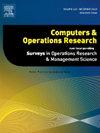Transportation infrastructure maintenance planning: An exact column enumeration approach
IF 4.3
2区 工程技术
Q2 COMPUTER SCIENCE, INTERDISCIPLINARY APPLICATIONS
引用次数: 0
Abstract
Transportation infrastructure assets deteriorate over time due to natural hazards, heavy traffic, and aging, increasing their risk of failure. National transportation agencies must strategically invest in maintenance to avoid significant social and economic impacts. We address the infrastructure maintenance planning problem, in which a maintenance plan must be designed for each asset within a budget limit to maximize the weighted average asset condition over a planning horizon. We derive a knapsack-type mathematical formulation and propose an exact column enumeration algorithm to solve it. First, a column-and-cut generation algorithm computes a (dual) upper bound on the optimal value. The master problem selects a maintenance plan for each asset and is strengthened with extended -cover inequalities. By representing maintenance plans as paths over a directed acyclic multigraph that captures asset deterioration and maintenance decisions, the pricing problems unveil feasible plans through a specialized labeling algorithm. Second, a relaxation-enforced neighborhood search finds a (primal) lower bound. Finally, using these bounds, we enumerate sufficient columns to find an optimal solution via a commercial MILP solver. Computational results on generated instances spanning a 10-year planning horizon demonstrate that our algorithm delivers optimal solutions for instances with up to 50 assets and near-optimal solutions (gap 0.18%) for instances with up to 100 assets within five hours.
交通基础设施维护规划:精确列枚举方法
由于自然灾害、繁忙的交通和老化,交通基础设施资产会随着时间的推移而恶化,从而增加其失效的风险。国家运输机构必须战略性地投资于维护,以避免重大的社会和经济影响。我们解决了基础设施维护计划问题,其中必须在预算限制内为每个资产设计维护计划,以最大化计划范围内加权平均资产状况。我们推导了一个背包式的数学公式,并提出了一种精确列枚举算法来求解它。首先,列切生成算法计算最优值的(对偶)上界。主问题为每个资产选择维护计划,并用扩展q-cover不等式进行强化。通过将维护计划表示为捕获资产劣化和维护决策的有向无环多图上的路径,定价问题通过专门的标记算法揭示可行的计划。其次,松弛强制邻域搜索找到一个(原始)下界。最后,使用这些边界,我们列举了足够的列,以通过商业MILP求解器找到最优解。在跨越10年规划范围的生成实例上的计算结果表明,我们的算法为拥有最多50个资产的实例提供了最优解决方案,为拥有最多100个资产的实例在5小时内提供了接近最优的解决方案(差距0.18%)。
本文章由计算机程序翻译,如有差异,请以英文原文为准。
求助全文
约1分钟内获得全文
求助全文
来源期刊

Computers & Operations Research
工程技术-工程:工业
CiteScore
8.60
自引率
8.70%
发文量
292
审稿时长
8.5 months
期刊介绍:
Operations research and computers meet in a large number of scientific fields, many of which are of vital current concern to our troubled society. These include, among others, ecology, transportation, safety, reliability, urban planning, economics, inventory control, investment strategy and logistics (including reverse logistics). Computers & Operations Research provides an international forum for the application of computers and operations research techniques to problems in these and related fields.
 求助内容:
求助内容: 应助结果提醒方式:
应助结果提醒方式:


